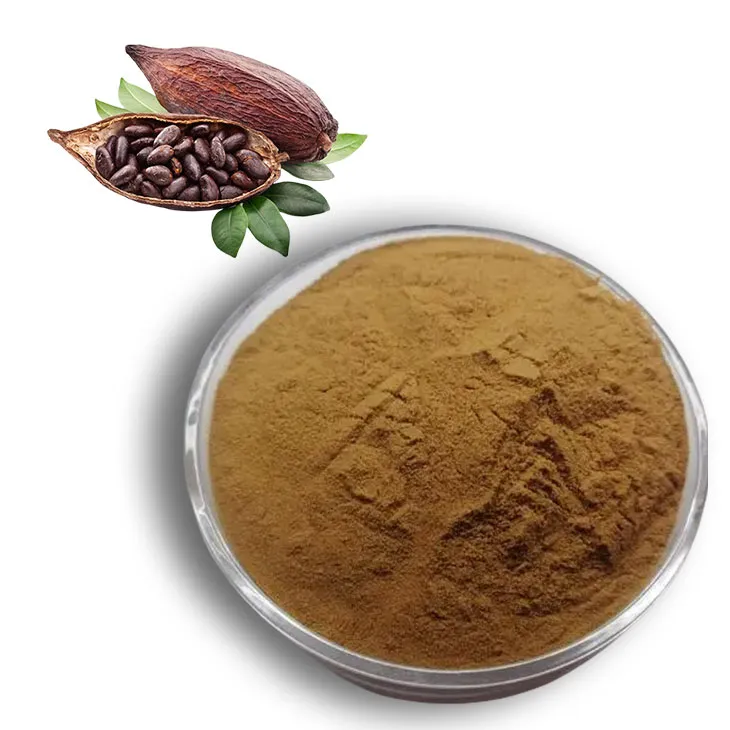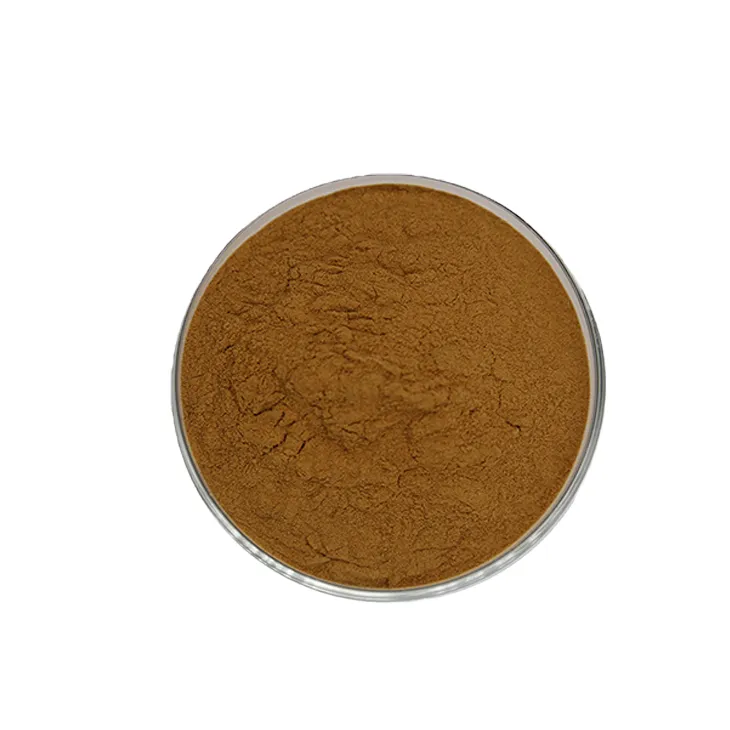- 0086-571-85302990
- sales@greenskybio.com
The process of extracting cocoa epicatechin from cocoa extract.
2024-11-26

1. Introduction to Cocoa Epicatechin
Cocoa epicatechin is a remarkable compound found in cocoa. It is part of a group of flavan - 3 - ols, which are well - known for their antioxidant properties. Cocoa epicatechin has been the subject of extensive research due to its potential health benefits. These benefits include but are not limited to, improving cardiovascular health, reducing the risk of certain cancers, and having anti - inflammatory effects. Cocoa, as the source of this valuable compound, is a complex matrix containing a variety of other substances such as fats, proteins, and other flavonoids. Thus, the extraction of cocoa epicatechin from Cocoa Extract is a challenging but important task.

2. Obtaining Cocoa Extract
2.1 Fermentation of Cocoa Beans
The first step in obtaining Cocoa Extract is the fermentation of cocoa beans. This is a natural process that occurs when the beans are removed from the cacao pods. Microorganisms such as yeasts, bacteria, and fungi play important roles during fermentation. Yeasts are usually the first to colonize the beans and start metabolizing the sugars present in the pulp surrounding the beans. This process produces ethanol and carbon dioxide. Bacteria, mainly lactic acid bacteria, then start to grow and convert the sugars into lactic acid. The production of lactic acid helps in reducing the pH of the environment around the beans, which is beneficial for the growth of other microorganisms.- Fermentation also helps in breaking down the cell walls of the beans, which makes it easier to extract the compounds later.
- It is a crucial step in the development of the characteristic chocolate flavor.
2.2 Roasting of Cocoa Beans
After fermentation, the cocoa beans are roasted. Roasting is carried out at different temperatures and for different durations depending on the desired flavor profile. During roasting, several chemical and physical changes occur in the beans.- The heat causes the Maillard reaction to take place. This reaction between amino acids and reducing sugars results in the formation of new flavor compounds and the characteristic brown color of roasted cocoa.
- Roasting also helps in reducing the moisture content of the beans, which is important for further processing.
- Some of the volatile compounds are removed during roasting, which can have an impact on the final flavor of the cocoa extract.
2.3 Grinding and Pressing
Once the beans are roasted, they are ground into a paste known as cocoa liquor. This is usually done using a grinder or a mill. The cocoa liquor contains both cocoa solids and cocoa butter. To obtain the cocoa extract, the cocoa liquor is then pressed to separate the cocoa butter from the cocoa solids.- The remaining cocoa solids are further processed to extract the desired compounds, including cocoa epicatechin.
- Pressing can be done using mechanical presses or hydraulic presses, and the efficiency of this step can affect the quality and yield of the final cocoa extract.

3. Solvent Extraction
3.1 Selection of Solvents
Solvent extraction is a key step in isolating cocoa epicatechin from the cocoa extract. Organic solvents are commonly used for this purpose. Ethanol and methanol are two of the most frequently used solvents. These solvents are chosen because they are able to selectively dissolve the epicatechin and other related flavonoids from the cocoa extract.- Ethanol is a relatively safe solvent to use, especially in food - related applications, as it is less toxic compared to some other solvents.
- Methanol, on the other hand, has a higher solubility for some of the compounds in cocoa extract, but it requires more careful handling due to its toxicity.
3.2 The Extraction Process
The extraction process involves mixing the cocoa solids (obtained after pressing) with the selected solvent. This is usually done in a closed vessel to prevent the evaporation of the solvent. The mixture is then stirred or agitated for a certain period of time to ensure proper extraction.- The temperature and time of extraction are important factors that need to be optimized. Higher temperatures can increase the rate of extraction, but it may also lead to the degradation of some of the compounds.
- The ratio of cocoa solids to solvent also affects the extraction efficiency. A higher solvent - to - solids ratio may result in a more complete extraction, but it also means more solvent is required, which can be costly.

4. Purification of Cocoa Epicatechin
4.1 Chromatography
After the solvent extraction, the resulting extract contains not only cocoa epicatechin but also other substances. Chromatography is a powerful technique used for the purification of cocoa epicatechin. High - performance liquid chromatography (HPLC) is one of the most commonly used chromatographic methods in this context.- In HPLC, the extract is injected into a column filled with a stationary phase. A mobile phase, which is a liquid solvent, is then pumped through the column at a constant flow rate.
- Different compounds in the extract interact differently with the stationary and mobile phases, resulting in their separation as they move through the column.
- The elution time of cocoa epicatechin can be determined based on its chemical properties and the conditions of the chromatography system. This allows for the collection of the pure cocoa epicatechin fraction.
4.2 Other Purification Methods
Besides HPLC, there are other purification methods that can be used in combination or as alternatives.- Column chromatography using different types of resins can also be effective in separating cocoa epicatechin from other compounds. For example, ion - exchange resins can be used to separate compounds based on their charge properties.
- Preparative thin - layer chromatography can be used for small - scale purification. In this method, a thin layer of adsorbent material is used, and the extract is spotted on it. The different compounds move at different rates on the layer, allowing for their separation.

5. Quality Control and Analysis
5.1 Chemical Analysis
Once the cocoa epicatechin has been purified, it is necessary to carry out quality control and analysis. Chemical analysis methods are used to determine the purity and concentration of cocoa epicatechin.- UV - Vis spectroscopy can be used to measure the absorbance of cocoa epicatechin at a specific wavelength. This can give an indication of its concentration in the sample.
- High - resolution mass spectrometry can be used to accurately determine the molecular weight of cocoa epicatechin and to detect any impurities or related compounds that may be present.
5.2 Biological Activity Testing
In addition to chemical analysis, biological activity testing is also important to confirm the functionality of the purified cocoa epicatechin.- Antioxidant assays can be carried out to measure the antioxidant capacity of cocoa epicatechin. These assays can include methods such as DPPH (2,2 - diphenyl - 1 - picrylhydrazyl) radical scavenging assay, ABTS (2,2' - azinobis - (3 - ethylbenzothiazoline - 6 - sulfonic acid)) radical cation decolorization assay, etc.
- Cell - based assays can be used to study the effects of cocoa epicatechin on cell viability, proliferation, and other cellular functions. For example, its effects on endothelial cells can be investigated to understand its potential role in cardiovascular health.
6. Conclusion
The extraction of cocoa epicatechin from cocoa extract is a multi - step process that involves careful handling of cocoa beans, selection of appropriate solvents, purification techniques, and quality control. Each step is crucial in obtaining a high - quality product with a high concentration of cocoa epicatechin. With the increasing awareness of the health benefits of cocoa epicatechin, the development of more efficient and sustainable extraction methods will be of great importance in the future. This will not only enable the production of high - quality cocoa - derived products but also contribute to further research and applications in the fields of nutrition and medicine.
FAQ:
Q1: Why is the fermentation and roasting of cocoa beans important in the process of obtaining cocoa extract for cocoa epicatechin extraction?
Fermentation and roasting are crucial steps as they not only develop the flavor of the cocoa beans but also impact the composition of the extract. These processes help in making the cocoa extract suitable for further extraction of cocoa epicatechin and other bioactive compounds.
Q2: What are the advantages of using organic solvents like ethanol or methanol in the solvent extraction step?
Ethanol or methanol are used because they can selectively dissolve the epicatechin and other related compounds from the cocoa extract. They have the ability to target and extract these specific substances while leaving behind unwanted components, which is beneficial for isolating cocoa epicatechin.
Q3: How does high - performance liquid chromatography (HPLC) work in purifying cocoa epicatechin?
HPLC works by separating the components in a mixture based on their different interactions with a stationary phase and a mobile phase. In the case of cocoa extract, it can distinguish and separate cocoa epicatechin from other substances present in the extract, thus purifying it and ensuring a high - quality product with a high concentration of the desired compound.
Q4: Are there any other purification techniques that can be used instead of HPLC?
There are other chromatography techniques that can potentially be used, such as gas chromatography in some cases, but HPLC is often preferred for its high precision and effectiveness in separating and purifying cocoa epicatechin from the complex cocoa extract. However, different techniques may be explored depending on the specific requirements and available resources.
Q5: What are the health - promoting properties of cocoa epicatechin?
Cocoa epicatechin has several health - promoting properties. It has antioxidant properties, which can help in reducing oxidative stress in the body. It may also have potential benefits for heart health, such as improving blood vessel function and reducing inflammation. Additionally, it may play a role in cognitive function improvement and has been studied for its anti - aging effects.
Related literature
- Cocoa Epicatechin: A Review of Its Bioavailability and Health Benefits"
- "Extraction and Characterization of Bioactive Compounds from Cocoa: Focus on Epicatechin"
- "The Role of Cocoa Epicatechin in Cardiovascular Health: A Comprehensive Review"
- ▶ Hesperidin
- ▶ citrus bioflavonoids
- ▶ plant extract
- ▶ lycopene
- ▶ Diosmin
- ▶ Grape seed extract
- ▶ Sea buckthorn Juice Powder
- ▶ Beetroot powder
- ▶ Hops Extract
- ▶ Artichoke Extract
- ▶ Reishi mushroom extract
- ▶ Astaxanthin
- ▶ Green Tea Extract
- ▶ Curcumin Extract
- ▶ Horse Chestnut Extract
- ▶ Other Problems
- ▶ Boswellia Serrata Extract
- ▶ Resveratrol Extract
- ▶ Marigold Extract
- ▶ Grape Leaf Extract
- ▶ blog3
- ▶ blog4
-
Chinese Withania somnifera Extract Factory.
2024-11-26
-
中国松树皮提取物粉粉末供应商
2024-11-26
-
High - quality Marigold Extract Products.
2024-11-26
-
100% Pure Natural Mango - Flavored Powder.
2024-11-26
-
Bitter Melon Extract
2024-11-26
-
Citrus Aurantii Extract
2024-11-26
-
Golden Seal Extract
2024-11-26
-
Uridine-5'-monophosphate Disodium salt
2024-11-26
-
Sophora Japonica Flower Extract
2024-11-26
-
Shikonin
2024-11-26
-
Black Pepper Extract
2024-11-26
-
Maca Extract
2024-11-26
-
Fig Extract
2024-11-26
-
Kelp Extract Powder
2024-11-26





















